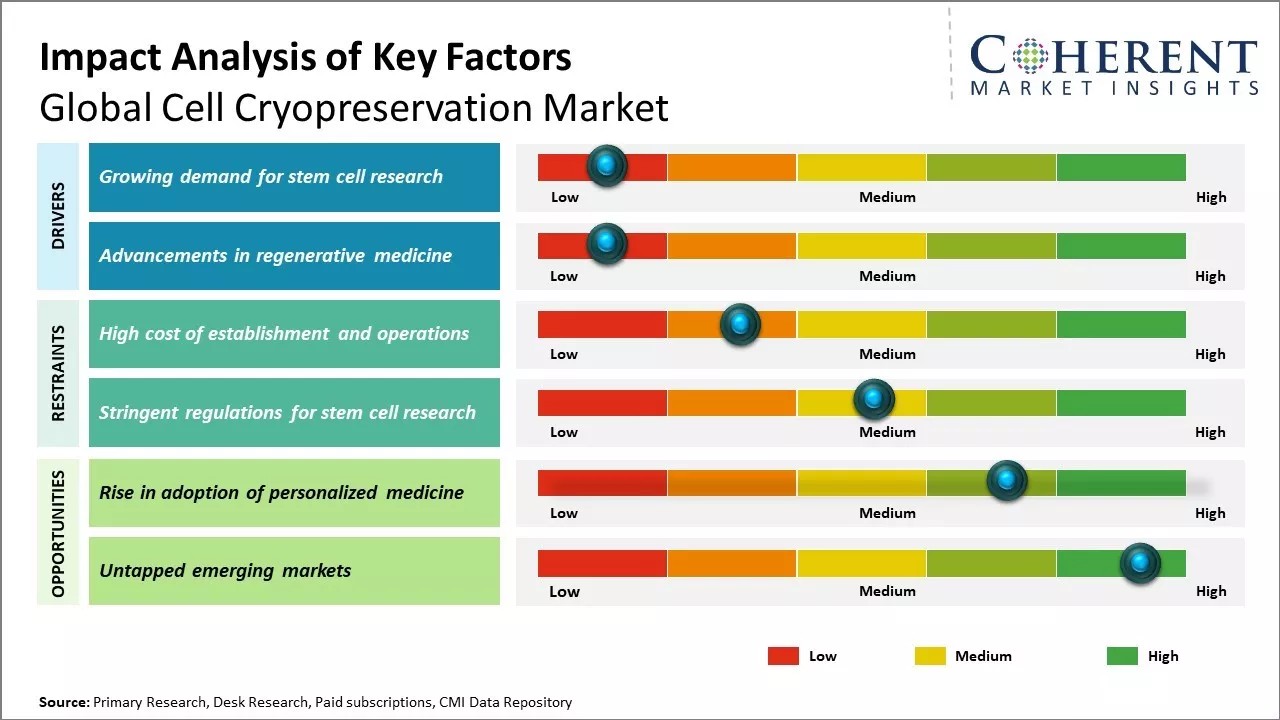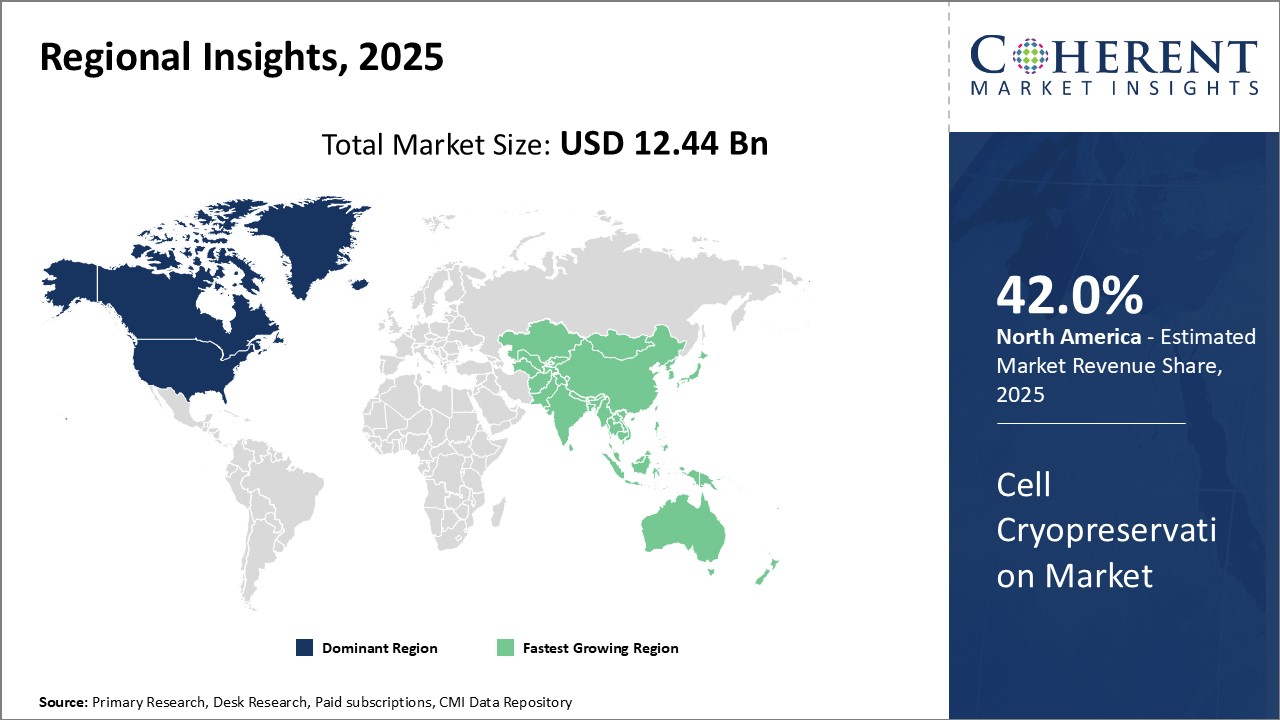Global cell cryopreservation market is estimated to reach at USD 53.64 Bn by 2032 from USD 12.44 Bn in 2025. Sales are likely to reach at a CAGR of 23.2% from 2025 to 2032.

To learn more about this report, Download Free Sample
Growing prevalence of chronic diseases coupled with rising investments in R&D of regenerative medicine can drive the global cell cryopreservation market growth.The market is witnessing various innovations that aid in commercialization and uptake of cell cryopreservation technologies. There has been an increased focus on developing techniques that can better preserve cell viability and functionality post-thaw. Cryopreservation of stem cells and genetically modified cells can offer opportunities for applications in drug discovery, personalized medicine and disease modeling over the forecast period.
|
Current Event |
Description and its impact |
|
Integration of AI and Automation in Cryopreservation Protocols |
|
|
Development of Serum-Free and Chemically Defined Cryopreservation Media |
|
|
Adoption of Blockchain Technology in Biobanking |
|
Uncover macros and micros vetted on 75+ parameters: Get instant access to report
Cell cryopreservation on a global scale is predicted to grow in the upcoming years due to an increase in demand for stem cell research. Stem cells assist in preparing new treatments for numerous chronic and terminal diseases such as cancer, diabetes, heart diseases, and neurodegenerative disorders. One of the most important milestones in stem cell research is the ability to efficiently preserve stem cells through cryopreservation which enables the long-term storage and transport of viable stem cells. The active research being done towards stem cells’ unique capabilities of differentiation and regeneration is anticipated to lead to numerous targets and cell-based therapies.
Investments into advancing stem cell science are not only looked into privately but also publicly. Millions of dollars are allocated by the National Institute of Health in the US towards initiatives focused on stem cells and several biopharma companies and boosting their R&D in stem cell therapies. With the stem cell research advancements, the needs from cell cryopreservation increases to sample volume, infrastructure, and regulatory compliance.
Different types of stem cells require reliable preservation over a stretch for varied applications which range from basic research to clinical translation for advanced medical treatment. For example, for U.S. National Institutes of Health set aside millions to fund stem cell projects. A number of biopharma firms have also increased their research and development efforts targeted at stem cell therapies. Encouraging advancements in stem cell research results in increased requirements for cryopreserved cells in terms of increased sample volumes, infrastructural sophistication, and heightened regulatory compliance.
Researchers require dependable stem cell preservation features so they can store them for long periods, especially for primary research and clinical work. For example, in January 2025, researchers from UC Davis Health plan to conduct further tests on a stem cell therapy to evaluate its effectiveness in treating Crohn’s disease which has shown promising results during preclinical trials.
Technological advancements in the field of regenerative medicine boost market growth. Regenerative therapies aim to repair or replace damaged cells, tissues and organs through stimulating the body's innate healing response. Some key areas witnessing ground-breaking progress includes tissue engineering, organ engineering and development of artificial organs.
Several clinical trials are exploring the application of tissues grown from cryopreserved cell sources such as skin, bone marrow and heart valves for reconstructive procedures. Emerging field of 3D bioprinting also relies on cryopreserved cell viability for printing transplantable organs and implantable tissues. For example, scientists have successfully 3D printed heart patches, liver tissue and bone structures using living cells.
With the increasing intake and acceptance of personalized medicine, the cell cryopreservation market will inevitably surge. Tailored treatment approaches to specific patients on a molecular level known as Personalized medicine is advanced with these surgical innovations.
The movement toward tailor-made healthcare is especially potent for a patient's retrieval and storage system of cells. Healthcare providers are more likely to make use of a “default” backup which is ready for research at a minute's notice, resulting in significant time savings. A patient whose cells are kept for decades or more will benefit from being able to retain the guards her blood cells and tissue are frozen in. Stem cells from Umbilical Cord blood or Adipose Tissue Stem Cells are excellent for future use as regenerative medicine. These stem cells are eligible to be harvested and corralled in biobanks.
There will be a drastic increase in the availability of personalized medicine accompanied by genomics-based diagnostics and treatment that will drive the demand for cryopreservation services tremendously. This will be from healthcare providers, biobanks and patients themselves who want to store their own cells and bio-samples. According to the World Marrow Donor Association, over 35 million umbilical cord blood units have been cryopreserved globally in public and private biobanks in 2021.
The equipment segment is postulated to gain the highest market share of 60.6% in 2025 due to growing demand from biopharmaceutical companies and research institutions. With the evolution in cell-based studies, there is an increased need for advanced techniques of cryopreservation for biological materials transport and storage. There is increasing adoption of ultra-low temperature freezers, liquid nitrogen tanks, and cryogenic vials because of their importance in storing samples.
Responding to these needs, manufacturers are developing highly automated and tailored equipment with features such as precise temperature control, real-time tracking systems, and cloud monitoring tailored for large-scale biobanks and regenerative medicine research centers. Besides aiding in sample transport, these innovations enable global research collaboration by providing precise custodial control and long distance transportation security.
The stem cells segment was valued at 30.7% in 2025 and will continue to grow due to increased demand in regenerative medicine and therapeutic research. Stem cells are increasingly utilized for various chronic conditions like leukemia, blood disorders, and cartilage injuries. Umbilical Cord-Derived Stem Cells (UCSCs) have shown clinical promise in treating neurological disorders including, but not limited to, cerebral palsy, autism, and multiple sclerosis.
Advanced technologies in stem cell therapy for complex conditions such as Parkinson’s disease, heart failure, and diabetes are continuously emerging. Active clinical trials for Alzheimer’s disease, some spinal cord injury types, and macular degeneration are increasing the scope of therapeutics. To meet these growing needs, hospitals and bio banks are strengthening their capabilities in the storage and distribution of well-characterized stem cell lines for biobanking. These stem cells are essential for the prospective clinical and drug development landscape, making them a primary application in cryopreservation.
Pharmaceutical and biopharmaceutical companies captured the most market share, 40.7%, around 2025 owing to their vast in-house R&D activities. Such companies make extensive use of cryopreserved cells in preclinical testing, efficacy studies, and drug discovery. Following the successful commercialization of cell and gene therapies, there is increased market demand for strong preservation systems to maintain biological sample reproducibility and adhere to regulatory guidelines. Pharma companies are vaulting proprietary and long-term use targeted therapy and biomarker discovery cell line repositories as well.

To learn more about this report, Download Free Sample
North America is projected to maintain the largest share of the cell cryopreservation market, with an anticipated share of 42.0% by 2025. The life sciences market in Canada and The United States have dominantly positioned themselves as leaders owing to the robust healthcare infrastructure, tremendous R&D spending, and benevolent policies. The strength of the region lies in the high biopharmaceutical industry which is heavily dependent on cryopreservation techniques for regenerative medicine, cell based therapies, and cell therapy. Key players such as Thermo Fisher Scientific and BioLife Solutions helps North America retain its position as a leader in innovation sites in cryopreservation solutions.
Asia Pacific is emerging as the fastest growing regional market for cell cryopreservation. The region generated 1,743.7 Million USD in 2023 and is projected to have an estimation of 6,814.9 Million USD by 2030, with a CAGR of 21.5% from 2024 to 2030. Countries such as China, India, Japan, and South Korea are significantly enhancing their life science capabilities. The supporting set of policies from the government like ICMR and DBT which promote Stem cell research along with “Made in China 2025” policy further bolster the estimate for these.
The advancement of bio banking and regenerative medicine is enabling Europe to advance further into the cell cryopreservation market. Germany, United Kingdom, and France are supported by very strong healthcare policies, which also support cell based research and innovation, meaning these countries are leaders in innovation. The European Medicines Agency (EMA) has set severe rules for application of cell therapy procedures which is preserving their integrity and ensuring compliance with cell integrity.
The ath region which includes Saudi Arabia, UAE, and South Africa is slowly starting to grow in the cell cryopreservation market. As of now the market share in this region is lower than other regions, but increasing usage of cryopreservation techniques is encouraging. Investment into modernizing healthcare and adoption of advanced cryopreservation techniques for stem cell banking and regenerative medicine is increasing.
Research indicates that the market is Dominated by the United States, which is expected to lead the market during the projection period. Their well established biotechnology and pharma sector along with strong research and development activities ensures that gap will continue to widen. The presence of key market players also drives demand in the market. As an example in October 2024 Nucleus Biologics announced the launch of their new DMSO free chemically defined cryomedia set NB-KUL DF, a DMSO-free and chemically-defined cryomedia set.
Storage costs are usually calculated per sample, per vial, or by volume (e.g., per mL or per cryovial), and vary by storage duration.
As technology progresses, users across the market report adopting new features and sharing feedback, which remains optimistic, albeit adaptive over time.
As a whole, respondents remain in a positive net balance, which indicates that most users regard cryopreservation as the basic foundation for the growth of reproductive medicine, personalized therapy and regenerative medicine. Market Report Scope
Cell Cryopreservation Market Report Coverage
| Report Coverage | Details | ||
|---|---|---|---|
| Base Year: | 2024 | Market Size in 2025: | USD 12.44 Bn |
| Historical Data for: | 2020 To 2024 | Forecast Period: | 2025 To 2032 |
| Forecast Period 2025 to 2032 CAGR: | 23.2% | 2032 Value Projection: | USD 53.64 Bn |
| Geographies covered: |
|
||
| Segments covered: |
|
||
| Companies covered: |
Thermo Fisher Scientific Inc., Merck KGaA, GE Healthcare, Lonza Group Ltd., STEMCELL Technologies Inc., BioLife Solutions, Inc., Cryolife, Inc., Organ Recovery Systems Inc., Custom Biogenic Systems, Sartorius AG, Takara Bio Inc., Chart Industries, Inc., Biocision, LLC, Cardinal Health, Inc., Helmer Scientific |
||
| Growth Drivers: |
|
||
| Restraints & Challenges: |
|
||
Uncover macros and micros vetted on 75+ parameters: Get instant access to report
*Definition: The global cell cryopreservation market consists of companies that provide cell and tissue cryopreservation services and products for research and therapeutic applications. These supply cryopreservation media, storage containers, cooling equipment, and sample management software that allow biological samples such as stem cells, cells, and tissues to be preserved at very low temperatures (-80°C or below) for long periods of time. This preservation allows samples to be stored and maintained for future use in applications like regenerative medicine, drug discovery, and biobanking.
Share
Share
About Author
Nikhilesh Ravindra Patel is a Senior Consultant with over 8 years of consulting experience. He excels in market estimations, market insights, and identifying trends and opportunities. His deep understanding of the market dynamics and ability to pinpoint growth areas make him an invaluable asset in guiding clients toward informed business decisions. He plays a instrumental role in providing market intelligence, business intelligence, and competitive intelligence services through the reports.
Missing comfort of reading report in your local language? Find your preferred language :
Transform your Strategy with Exclusive Trending Reports :
Frequently Asked Questions
Joining thousands of companies around the world committed to making the Excellent Business Solutions.
View All Our Clients